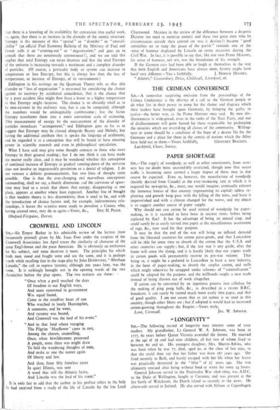ENTROPY
Snt,—In his review of Professor Irwin Schrodinger's recent book, What is Life? Mr. W. J. Turner complains that the writer's science is not clear in his section on Entropy. This is hardly surprising, as most text-books and authorities confess to a difficulty in stating just what it is. I have called it "it," but it is not a thing that can be put in a test- tube or measured directly by an instrument, but it is none the less precise and definite numerically. Entropy was at first only a mathematical device found very serviceable by engineers in dealing with problems arising from the use of steam, but more recently it has become the current coin of physicists, astronomers and philosophers, and when some among them such as Eddington, Jeans or Professor Schriidinger write without technical symbolism for the general reader, they do not hesitate to allude to the conception of Entropy.
It is found that heat can only be transferred from a body or substance at a higher temperature to one at a lower, and this is known as the Second Law of Thermodynamics ; but physicists describe this by saying that when heat transference takes place there is a spread Of energy and
in there is a lowering of its availability for conversion into useful work, r, again, that there is an increase in the disorder of the atomic structure. ntropy is the measure of this " spread " or " disorder " or " unavail- bility " (an official Fuel Economy Bulletin of the Ministry of Fuel and • ‘ower calls it an " evening-out " or "degeneration," and goes on to lemark that these are notoriously synonomous!), and we are told this implies that total Entropy can never decrease and that the total Entropy of the universe is increasing towards a maximum and a complete disorder of particles. (Of course, a particular body or system can increase in temperature or lose Entropy, but this is always less than the loss of temperature, or increase of Entropy, of its environment.) Eddington in his writings on the Quantum Theory tells us that this disorder or "loss of organisation" is measured by considering the chance against its recovery by accidental coincidence, that is the chance that by a pure accident heat might flow from a lower to a higher temperature or that Entropy might decrease. The chance is so absurdly small as to be non-existent in the ordinary way, but it can be computed, although the numbers would be unimaginably cumbersome ; but the factor Entropy transforms them into a more convenient scale of reckoning. This measurement of energy by the measurement of the disorder of particles introduces "arrangement," and Eddington goes so far as to suggest that Entropy may be classed alongside Beauty and Melody, but having the additional attribute that it speaks the language of arithmetic, and he regarded it as a conception that will be found to have amazing power in scientific research and even in philosophical speculation.
What I have said may give some thought contacts to those who meet Entropy in their general reading ; but I do not think it can have made the matter really clear, and it may be wondered whether this conception of continual increase of Entropy or gradual running-down of the universe does not involve an impenetrable pessimism or a denial of religion. I do not venture a definite pronouncement, but two lines of thought seem possible. One is that the ever-Changing and marvellous conceptions surrounding, shall we say, a fourth dimension and the curvature of space- time may lead to a result that shows that energy, disappearing at one place, appears at another where least expected. Another line of thought is that modern theory is less deterministic than it used to be, and with the introduction of chance factors and, for example, indeterminate rela- tionships, it leaves the scientist more ready to postulate a Creator who,



























 Previous page
Previous page